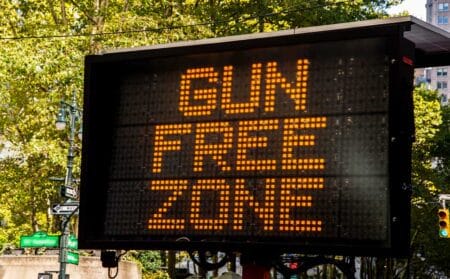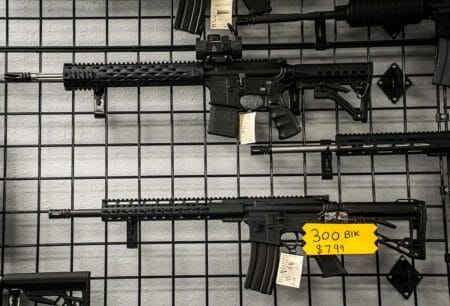
Arizona -(Ammoland.com)- Gary Kleck, the award-winning criminologist who documented significant levels of defensive gun use (DGU) in American society, has uncovered research done by the CDC that strongly corroborates his findings. Kleck and Gertz’s seminal study was done in 1993, presented in 1994, and published in 1995.
The CDC research was done in 1996, 1997, and 1998, but was never publicized.
The BRFSS surveys are high-quality telephone surveys of enormous probability sample of U.S. adults, asking about a wide range of health-related topics. Those that addressed DGUasked more people about this topic than any other surveys conducted before or since. For example, the 1996 survey asked the DGU question of 5,484 people. The next-largest number questioned about DGU was 4,977 by Kleck and Gertz (1995), and sample sizes were much smaller in all the rest of surveys on the topic (Kleck 2001).
The wording of the DGU question in the BRFSS surveys was also excellent, addressing many problems with the wording of the DGU questions used in other surveys. The exact wording was:
“During the last 12 months, have you confronted another person with a firearm, even if you did not fire it, to protect yourself, your property, or someone else?”
Respondents had previously been instructed not to report firearm uses associated with an occupation that “requires and authorizes you to use a firearm.” Thus, the question excluded uses by police and others with firearm-related jobs. Further, the question appropriately excluded uses against animals (“…another person…”), asked about a specific, recent recall period (“during the last 12 months”), covered uses by any type of firearm (not just handguns), covered uses regardless of where they occurred (not just uses in the home), and explicitly told respondents that they should report uses even if they did not fire a gun. In sum, the surveys used an excellent, carefully worded DGU question, in contrast to the wordings used in so many other surveys (Kleck 2001).
The CDC did not directly mention the results of 1996, 1997, and 1998 research in the paper done on gun control that was overseen by the CDC in 2013. That paper had been asked for President Obama. Defensive gun use research was considered. From the 2013 CDC paper:
Defensive Use of Guns
Defensive use of guns by crime victims is a common occurrence, although the exact number remains disputed (Cook and Ludwig, 1996; Kleck, 2001a). Almost all national survey estimates indicate that defensive gun uses by victims are at least as common as offensive uses by criminals, with estimates of annual uses ranging from about 500,000 to more than 3 million (Kleck, 2001a), in the context of about 300,000 violent crimes involving firearms in 2008 (BJS, 2010). On the other hand, some scholars point to a radically lower estimate of only 108,000 annual defensive uses based on the National Crime Victimization Survey (Cook et al., 1997). The variation in these numbers remains a controversy in the field. The estimate of 3 million defensive uses per year is based on an extrapolation from a small number of responses taken from more than 19 national surveys. The former estimate of 108,000 is difficult to interpret because respondents were not asked specifically about defensive gun use.
The paragraph above does not rule out the surveys done by the CDC. It says that “more than 19 national surveys” not “19 national surveys”. Were the authors aware of the CDC surveys done in 1996, 1997, and 1998, that essentially confirmed the estimates made by Kleck and Gertz in the 1995 paper?

The timing and size of the surveys done by the CDC is fascinating. They were done immediately after Kleck and Gertz published their paper. There were three of them. The one in 1996 was the largest ever done. 5,884 people were asked the DGU question. The total number of people asked in the three surveys done by the CDC was 12,870. All were asked the same question. It is as if a single very large survey was done, over three years. Kleck and Gertz’ survey asked their DGU questions of 4,977 people.
Kleck goes into considerable detail about how his survey, done in 1993 (published in 1995) differs from the CDC survey. For example, in the CDC survey, only those people who admitted to having a gun in the home were asked the DGU question.
When Kleck applies the corrections to adjust for the differences in the surveys, the results are spectacularly close. Kleck and Gertz’s survey arrived at a number of 1.326% in 1995. The average in the three CDC surveys is 1.24%. The first, and largest survey (closest in time to the Kleck and Gertz survey) had a slightly larger number, and the two later surveys had a little smaller number.
Those numbers indicate about 2.5 million defensive gun uses a year in the United States, at a minimum. The numbers do not consider defenses against animals. There may be more defenses against animals than against people. I disagree with Kleck about excluding defenses against animals. Defending against an animal is just as real as defending against a person. Kleck mentions the strong possibility of false negatives, because nearly as many people answered “do not know” and “refused to respond” as answered affirmatively to the DGU question.
Having read the Kleck and Gertz paper, I often wished that someone would do another survey, to broaden the sample, to provide more data.
Now we find the CDC did three such surveys. All of them validated the Kleck and Gertz survey. One large survey, such as the one by Kleck and Gertz, is indicative. Four of them show scientific replication and add to certainty. We were never told of the results of the confirming surveys done by the CDC.
Gary Kleck, as a scientist, a Democrat, and a proponent of a number of gun control measures, is careful not to cast aspersions on the CDC. He does not accuse anyone of malfeasance. He notes the surveys were done during the Clinton administration, and these findings would have worked against the gun control agenda of the administration. Someone at the CDC made the decision not to publish these results.
Kleck, while doing research, happened to come across the DGU question in a historical CDC survey, online, 21 years after the CDC surveys had been completed.
He was intrigued and was able to find the original surveys done in 1996, 1997, 1998, and all the results.
It has to be gratifying to Dr. Kleck, to see his results validated after more than two decades. It may be infuriating to know these results were available from 1997 to 1999 and were never made public.
©2018 by Dean Weingarten: Permission to share is granted when this notice is included.
About Dean Weingarten
Dean Weingarten has been a peace officer, a military officer, was on the University of Wisconsin Pistol Team for four years, and was first certified to teach firearms safety in 1973. He taught the Arizona concealed carry course for fifteen years until the goal of constitutional carry was attained. He has degrees in meteorology and mining engineering, and recently retired from the Department of Defense after a 30 year career in Army Research, Development, Testing, and Evaluation.







Who, oh who at CDC might have made that most interesting of all decisions, the one that hides facts that would endanger the anti gunners ship of state? Could it possibly be that a government agency, one that survives on taxpayer appropriations, might possibly “cook the books” to achieve a politically desired conclusion not supported by the facts? Say it isn’t so Joe, say it isn’t so.
I don’t have/take the time to review studies such as the ones cited by Mr. Weingarten, though I’m happy when someone like him does. I seem to recall when the king (obama) directed the CDC to study gun use, based on his vast knowledge of the subject, he was confident they would declare gun violence a public health emergency. This would have allowed him further executive orders to implement gun control measures. When they reported defensive gun use was approximately at least 3x greater (I recall numbers of 100K, 260K, being bantered about) than the bloated 33K death cases, the… Read more »
Wow, just like global warming,, withheld and doctored “scientific” research. Seems to be another means to the progressive’s end. Do whatever it takes to achieve the intended goal
GW is real. The only argument left is how much has humanity added to it and sped it up.
Global Warming is NOT real… and until two things happen, it will never be real. When Global Warming actually begins to happen, 1) ocean levels will rise [as proven by satellite measuring systems, oceans today are actually 1/2″ LOWER than they were in 1970], and 2) carbon dioxide levels – currently at 400 parts per million (ppm) – will rise. Since carbon dioxide is a nutrient [not a “greenhouse gas,” carbon monoxide is the primary greenhouse gas] – as atmospheric CO2 increases vegetation becomes greener, lusher, hardier and more abundant – the levels of CO2 must rise above 1,000 ppm… Read more »
@Mike, I have to concur with you on so called global warming, doctored research, and the corrupt stealing of political power. The “Ends not justifying the Mean” used to be a commonly taught ethic. Modern people not only don’t ascribe to it, but have never even heard of it.
One question I would like to see asked is “if you fired your gun, did you need to reload?“
In the analysis of the 5 years of Armed Citizen articles, there were very few reloads.
In the “Daily feel good stories” on Thisainthell.com there are almost never stories where citizens reload during a defensive gun use.
This flies against the consensus on gun sites where everyone carries at least one reload.
It seems that it is extremely rare to reload in a civilian d g u.
Do you have a spare tire for your car, have ever had to use it?
Imagine that,I just can’t believe it,yeah right.